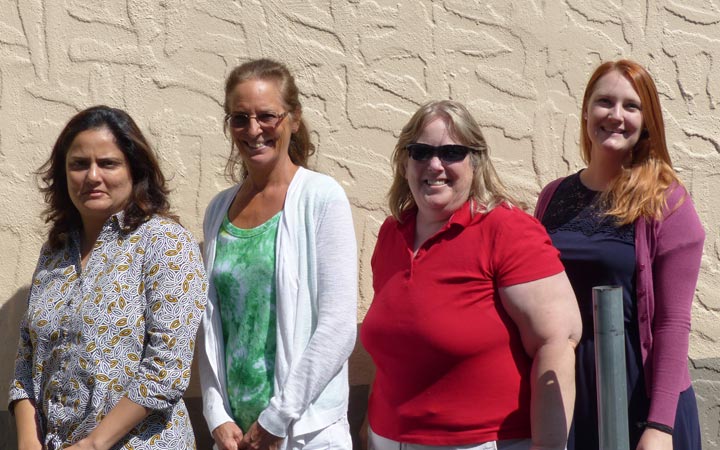
Liberty High School Faculty
Arooj Sayed, Gina Marquez, Christine Woodworth, Caroline Vannatta
San Jose’s Liberty High provides a second chance to students who did not thrive in traditional high schools. Some of these students are homeless. Some are supporting their families or have children of their own. Many have missed a lot of school and are behind in credits or have been expelled. They may have social and emotional disorders or come from dysfunctional families.
A year ago, the school replaced its literacy curriculum with the Markkula’s Ethic Center’s Character-Based Literacy (CBL) program. CBL provides daily learning plans aligned with the common core state standards.
The lesson plans use a holistic educational approach through the integration of activities that promote students’ expressive skills. Through artistic projects such as “Open Mind Portraits,” students imagine what the protagonist looks like and add information about the character’s traits, thoughts, and attitudes. Students’ extract evidence from the text while exercising perspective taking.
Teacher and instructional coach Gina Marquez has seen the schoolwide positive effects of the literacy program — by the end of the school year, 44 percent of Liberty’s students showed growth in their reading ability. If that sounds modest, it’s more than double the rate of growth in the previous year. “They’re enjoying reading, which is huge for our kids,” Marquez says “When they read ahead [of the daily learning plans] this is when you know you’ve got them.
Teacher Arooj Sayed sees the same phenomenon in her classroom. Some of the students jumped from a second grade to an eighth-grade reading level. “They’re reading better and writing better. I only had three out of 26 students who didn’t jump triple digits on their assessments.”
Marquez attributed students’ new motivation to learn to the book selection. Students can choose the books they would like to read. “We saw more work done and more positive attitudes towards reading assessments.”
Both teachers are also seeing a positive change in students’ ability to express themselves and talk with teachers about social and emotional issues. “For us, the books are great starting point to talk with students about what is happening in their life. We know more about their life because they write about it.” Marquez noted.
The program’s focus on “what it means to be a good member of society” encourages students to think about their own choices, Marquez has found. “I see it in their writing, where they acknowledge and own the things they’ve done that may have been irresponsible. It helps them identify their good traits and where they need growth.”
Caroline Vannatta has been teaching CBL for six years, so she felt right at home when she transferred to Liberty High last year. The program, she says, “increased the rigor and accountability” of the English language arts curriculum, and “students have risen to the challenge.” Students like the consistent structure of the program, which uses the PRREE framework: Prepare, Read, Respond, Explore, and Extend. Setting clear expectations for lesson structure and format supported both teachers’ preparation and student learning.
Vannatta also appreciates the fact that the lesson plans don’t just have students “read literature in a vacuum. It’s related to their own lives.” Last year, her students read The Circuit, about SCU Professor Francisco Jimenez’ childhood as an immigrant farmworker. “I have a lot of kids who are immigrants or whose families are immigrants,” Vannatta says. “Some students have very emotional reactions. They will say ‘Oh my God, He is getting deported.” With its focus on ethics and virtue, the curriculum allowed the class to use The Circuit as a jumping off point for discussions of social justice and “the meaning of America.”
The curriculum also relates to the students’ personal struggles, says 15-year veteran teacher Christine Woodworth. In the traditional high school, they may feel isolated and misunderstood. The books show them that they are not the only ones who confront these issues. They learn from role models who may have faced adversity, disability, or bad choices. Woodworth herself has struggled with a learning disorder, a fact that surprises and inspires her students, many of whom face their own learning challenges. “It’s nice for them to hear that I have been able to go to college and even graduate school,” she says.
Students cover six categories of social skills and virtues: courage, integrity, justice, leadership, responsibility, integrity, and change. “The curriculum puts these [character] traits on the students’ map,” Marquez says. "They can see, ‘Oh, that’s what responsibility looks like; that’s what courage looks like. Those are traits I might want to develop myself.”
That’s how it’s working out for one Liberty High junior. Peter’s favorite book from the curriculum last year was Ulysses. He liked the hero’s adventures, and, through the program, he could see his reading improve. Perhaps more important, he also learned to ask questions of himself, inspired by the literature, like “How am I going to make a difference in the world?”